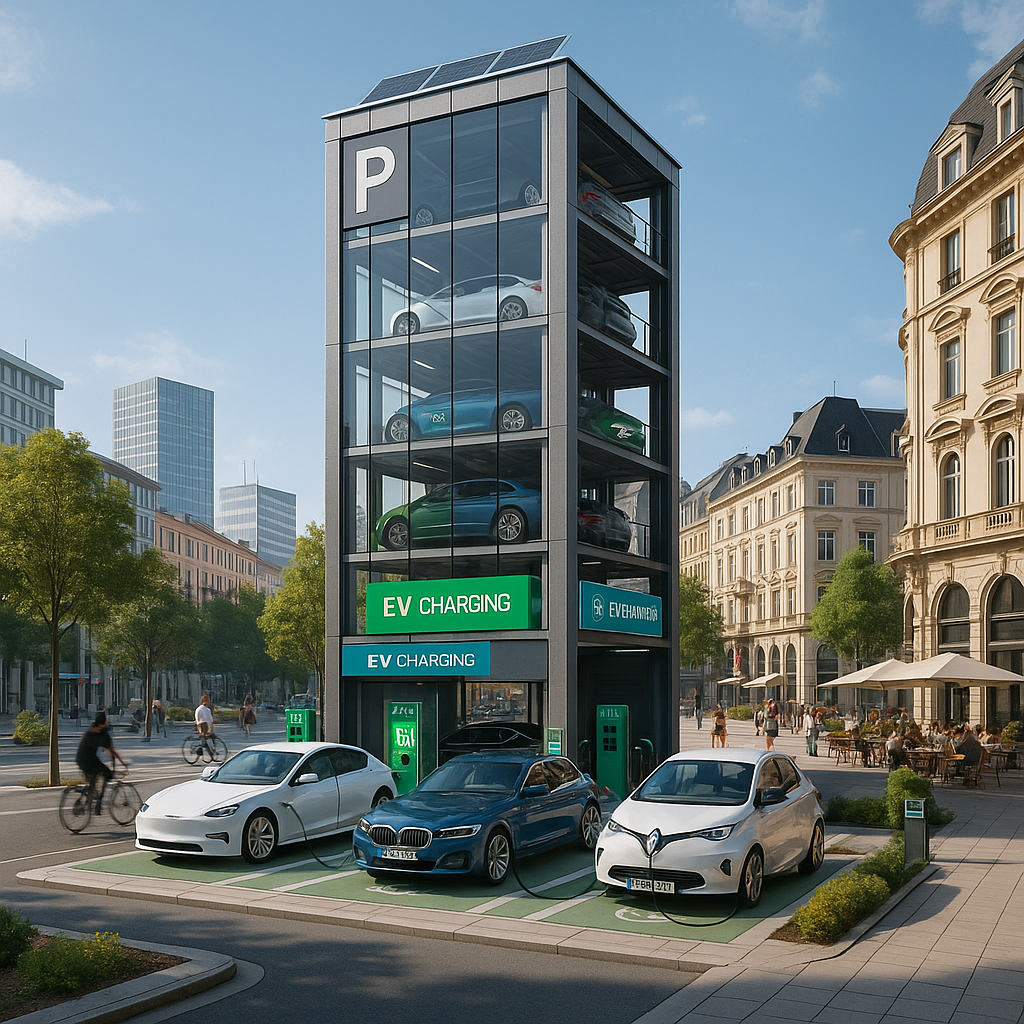European real estate is having a moment — and the smart money knows it. From green housing in Germany to coastal living in Spain, investors are shifting gears and placing bold bets across the continent. But this isn’t just about shiny buildings and postcard views. It’s about strategy, timing, and knowing exactly where opportunity is heating up. In this post, we’ll break down who’s investing, where the money’s flowing, and what developers like you need to watch in 2025 — without the fluff or financial jargon. Let’s dive in.
Top Investment Destinations in Europe — And Why They’re Hot Right Now
🏙️ Germany: The Safe Bet That Keeps Delivering
Let’s start with the classic. Germany remains one of the most reliable real estate markets in Europe — and for good reason.
If you’re looking for economic stability, high tenant demand, and predictable returns, cities like Berlin, Frankfurt, and Munich still lead the way. Investors love the German model: tight regulations, strong renter protections, and steady demand from both businesses and residents.
But here’s where it gets interesting — tier-two cities like Leipzig, Stuttgart, and Dresden are gaining traction. They offer better yields, lower entry costs, and growing infrastructure.
So, if you like slow and steady wins (with less risk), Germany should still be on your radar.
☀️ Spain: Affordable, Attractive, and Surprisingly Strategic
Ah, Spain. Great weather, amazing food… and some serious real estate opportunities hiding just below the surface.
Spain isn’t just about coastal resorts anymore. Yes, there’s still investor appetite in places like Marbella or Ibiza, but what’s really getting attention now are urban regeneration projects, student housing, logistics hubs, and energy-efficient residential developments.
Cities like Madrid, Barcelona, Valencia, and even Seville are becoming hotspots for smart capital. Why? Because Spain offers that rare mix of modern infrastructure, investor-friendly reforms, and very competitive pricing compared to Western Europe.
If you’re a developer looking for room to grow, Spain is quietly one of the most compelling markets in 2025. Plus, foreign investors love the lifestyle bonus — buying here doesn’t just make financial sense, it feels good too.
🌊 Portugal: The Coastal Darling of Foreign Investors
Portugal continues to charm investors with its Golden Visa appeal, affordable pricing (at least for now), and strong short-term rental market.
Lisbon and Porto have seen major growth over the past decade, but there’s still opportunity — especially in sustainable new builds, hospitality projects, and co-living spaces.
The government is tightening some of the visa rules, but the fundamentals are still solid: strong expat demand, tourism bounce-back, and a culture that’s very open to innovation.
If you’re building for global tenants, digital nomads, or retirees, Portugal offers a warm welcome and low barriers to entry.
🚚 Poland: The Underdog in Logistics and Light Industrial
If you’re not looking at Poland, you might be missing one of Europe’s best value plays — especially for logistics.
The rise of e-commerce, last-mile delivery, and industrial hubs in Central Europe has put Poland on the investor map. Cities like Warsaw, Wrocław, and Kraków are seeing demand for warehouses, mixed-use facilities, and high-density residential.
Add to that: favorable labor costs, business-friendly policies, and geographic positioning between East and West. It’s no wonder logistics funds and private equity firms are doubling down here.
Developers who focus on smart design and operational efficiency will find a receptive market — and likely some very eager tenants.
🇸🇪 Nordics: Small Markets, Big Sustainability Moves
Scandinavia isn’t cheap — but it’s very smart.
The Nordic countries continue to attract capital because of their deep commitment to sustainability, innovation, and future-proof infrastructure. If your project is ultra-green, tech-integrated, and built for long-term living, Sweden, Denmark, or Finland are great fits.
Family offices and pension funds particularly like the low risk, clean governance, and clear tenant demand. Just know: high standards come with high expectations.
So, if you’ve got a bold idea in sustainable living, this is the sandbox to build in — but you’ll need your A-game.
🧠 Final Thoughts: It’s Not Just Location — It’s Strategy
The “hot” destinations aren’t just the obvious ones anymore. While traditional cities still draw capital, the real opportunity lies in emerging urban centers, secondary markets, and projects that solve real problems.
Think beyond the skyline. Think mixed-use, think green, think digital infrastructure. And don’t be afraid to look where others haven’t — because that’s often where the best deals live.
And yes… if you’re still on the fence, Spain may quietly be the dark horse that wins the race in 2025.
💼 Who’s Investing? Family Offices, Funds, and Cross-Border Capital
Not all real estate money wears a suit and tie — but a lot of it does. In 2025, the European real estate market is seeing capital come from all directions. If you’re developing a project, it’s not just about what you’re building anymore — it’s about who you’re building it for.
Let’s break down who’s writing the checks, what they’re looking for, and how you can speak their language without sounding like a robot.
🧳 Family Offices: Playing the Long Game Quietly
If real estate investing were a party, family offices would be the guests who show up early, leave quietly, and still close the biggest deal.
These private investment vehicles — often representing ultra-high-net-worth families — aren’t chasing headlines. They’re looking for direct investments, stable returns, and long-term value.
Many family offices are diving deep into:
- Urban redevelopment projects
- Sustainable housing
- Income-generating residential portfolios
- Green infrastructure, especially in cities like Madrid, Lisbon, and Berlin
They love real estate because it’s tangible, predictable, and — let’s face it — way less chaotic than tech stocks. If you offer patient capital a clean, efficient project with a solid yield, you’ll probably catch their attention.
Oh, and a bonus? They prefer direct relationships. No flashy pitch decks required — just clarity, trust, and a bit of charm.
🌍 Cross-Border Capital: The World Wants a Piece of Europe
You might be surprised how international the money behind European real estate really is. From North America to the Middle East to Asia, global investors are hungry for reliable, euro-denominated assets.
So, who’s coming in strong?
- American private equity funds chasing value in Spanish and Portuguese residential markets
- Middle Eastern sovereign wealth funds targeting logistics and hospitality assets in Southern Europe
- Asian institutions focusing on core urban developments in capital cities
Why Europe? Because it offers relative political stability, modern infrastructure, a huge talent pool — and in many cases, better value than their home markets.
Spain, in particular, is benefiting from this surge. With solid returns, growing rental demand, and strategic connectivity, it’s becoming a favorite among cross-border buyers looking for a mix of lifestyle and yield.
If you can structure a project that checks local boxes but appeals to global taste — you’re in a powerful position.
🏦 Real Estate Funds & Institutional Capital: Big Money, Big Requirements
Let’s talk about the bigger fish — the real estate funds, pension funds, and institutional giants.
These investors are all about scale, systems, and security. They like clean governance, sustainability metrics, strong teams, and data-backed forecasts. If you can’t provide a full financial model and ESG plan… don’t bother.
But if you can, here’s what they’re loving right now:
- Logistics and light industrial hubs across Eastern and Central Europe
- Multifamily housing in high-demand cities like Warsaw, Barcelona, and Milan
- Mixed-use developments that integrate smart tech and green building principles
And here’s the secret: many of them are mandated to allocate to sustainable projects. If your development aligns with EU Green Deal goals, you’re instantly more fundable.
Just keep in mind — these investors don’t move fast. They move methodically. Be ready for a due diligence process that makes airport security look friendly.
🤝 It’s Not Just About the Money — It’s About the Match
Whether it’s a family office with patient capital, a Middle Eastern fund scouting Mediterranean deals, or a Nordic pension looking for low-risk green assets — everyone has a different approach.
Your job? Figure out who’s the right fit for your project.
Ask yourself:
- Does my deal offer stable income or fast upside?
- Is my asset class hot right now or niche and undervalued?
- Can I speak their language — financially and culturally?
Because in 2025, raising capital isn’t just about having a great project. It’s about finding a great partner who sees the future the way you do.
Final Thought: The Smart Money Is More Open Than You Think
The myth that investors are hard to reach or impossible to impress? It’s outdated.
Today’s capital — whether it’s coming from a family in Geneva or a fund in Abu Dhabi — is smarter, more diverse, and more accessible than ever.
If you can show real value, a clear plan, and a little personality? You’re not chasing capital — you’re attracting it.
Want help identifying the right type of investor for your project — or crafting the pitch they’ll actually read? Let’s talk
💸 Where Is the Money Coming From — And Where Is It Going?
In real estate, it’s not just about location — it’s also about capital flow. Knowing who’s funding what — and where — is a major advantage when you’re trying to attract the right partners, structure your next deal, or just understand where the action is.
So, let’s break down the real story behind Europe’s investment boom. Who’s bringing the money to the table — and where are they quietly placing their bets?
🌍 Global Capital Is Coming to Europe’s Backyard
Let’s start with the good news: Europe is still a magnet for global capital, and that momentum is growing in 2025.
A big slice of real estate investment is coming from North America, especially the U.S., where investors are looking for safer, more diversified long-term plays. With rising interest rates back home and market saturation in some sectors, European cities — particularly those in Southern and Central Europe — are looking very attractive.
You’re also seeing Middle Eastern sovereign wealth funds doubling down on European assets. Why? Because Europe offers stable governments, solid ESG regulations, and a growing appetite for green projects — all boxes they love to check.
And then there’s Asian institutional money — especially from Singapore, South Korea, and Hong Kong — flowing into urban infrastructure, residential projects, and logistics hubs across Europe. These players tend to be data-driven and risk-aware, but once they’re in, they’re in for the long haul.
🛬 Where the Money Is Landing: Not Just the Capitals Anymore
Sure, cities like London, Berlin, and Paris still grab headlines — and plenty of capital. But that’s not where all the opportunity lies anymore.
The real action? It’s shifting to secondary cities and emerging growth corridors. Think Valencia, Porto, Kraków, Wrocław, Seville, and Malaga. These markets offer strong fundamentals, lower costs, and increasing international attention.
Spain, for example, is seeing a surge in logistics investment, especially in areas near ports, airports, and trade routes. The mix of location, infrastructure, and lower development costs is proving irresistible to private equity and family offices alike.
Meanwhile, Portugal continues to attract hospitality and residential capital. Yes, some Golden Visa rules are changing — but the lifestyle and climate still draw demand, especially from Northern Europe and North America.
And in Central Europe, countries like Poland, Czech Republic, and Hungary are pulling in serious money for industrial parks, logistics centers, and affordable housing. The yields are strong, and the talent is local.
🔁 What’s Being Funded: Not Just Apartments and Offices
If you thought real estate investment was still about office towers and luxury condos, think again. The money is following big trends, not old-school formulas.
Here’s what’s getting funded right now:
- Green real estate — energy-efficient buildings, retrofits, and sustainable urban housing projects
- Last-mile logistics — especially in city-fringe zones where delivery demand is booming
- Build-to-rent and co-living spaces — especially for young professionals, students, and digital nomads
- Smart infrastructure — real estate that integrates renewable energy, digital connectivity, and automated building systems
- Tourism-driven redevelopment — especially in coastal cities in Spain, Greece, and Portugal, where demand is back
What do these projects have in common? They’re future-focused, ESG-aligned, and often backed by government grants or public-private funding schemes.
If your project checks even two of those boxes, you’re speaking the same language as most institutional investors in Europe right now.
💡 Follow the Flow — And Position Yourself Ahead of It
The best developers aren’t just watching capital move — they’re setting up before it arrives.
That’s where the real opportunity lies: understanding what capital wants, knowing where it’s going, and aligning your strategy so it fits right into the flow.
So, where’s the money coming from?
Global investors with big ambitions and sustainability goals.
And where’s it going?
Straight into places that are growing, evolving, and offering better value — like Spain, Portugal, and Central Europe.
Final Thought: Follow the Funds, Build What Matters
You don’t need a crystal ball to see where capital is flowing. You just need to stay curious, stay strategic, and build things that matter.
Whether you’re developing student housing in Seville or a solar-powered logistics hub near Warsaw — someone out there is looking to fund exactly that.
Know your value, track the trends, and stay one step ahead. Because in real estate, timing isn’t just everything — it’s money.
Need help shaping your project to attract capital? Or identifying the right markets to focus on next? Let’s chat.
🚀 What Developers Need to Do to Attract Smart Capital in 2025
Raising money isn’t magic. It’s strategy — and in 2025, real estate developers need more than a pretty render to get a yes.
The capital is out there. Investors are eager to place money in sustainable, long-term projects. But here’s the catch: they’ve become pickier, savvier, and a little allergic to vague ideas. If you want smart capital, you’ve got to look like a smart developer.
Let’s dive into what you can do to stand out and make investors want to chase you (instead of the other way around).
📦 Package Your Project Like a Pro
First impressions still matter — especially when you’re asking someone to invest millions into your vision.
You need a clear, concise, and credible pitch package. Not a 47-slide deck full of buzzwords and aerial photos. Think simple, sharp, and strategic.
At the very least, make sure you’ve got:
- A one-page executive summary (the “why” and “what” of your project)
- A well-designed, focused pitch deck (15 slides max)
- A realistic, professional-looking financial model
- A clean data room with supporting docs, permits, timelines, and projections
This shows that you respect the investor’s time and that you’ve done your homework. If your materials are messy or incomplete, you risk being seen as high-risk — even if your idea is gold.
🌿 Build With Purpose — Not Just for Profit
Today’s investors aren’t just looking for returns. They’re looking for relevance — and that means building projects with purpose and impact.
In 2025, you’ll get more attention if your development solves a problem. That might mean:
- Affordable housing in high-demand cities
- Energy-efficient buildings that meet EU green standards
- Mixed-use projects that create community, not just square meters
- Student housing, co-living, or BTR (build-to-rent) models that serve shifting lifestyles
If you can show how your project contributes to sustainability, accessibility, or social value, you’ve already differentiated yourself from 80% of the market.
Also, don’t be afraid to highlight the human side of your project. Investors love numbers, yes — but they also love stories that align with their values.
🌍 Know Your Market — And Know It Better Than Google
Investors want confidence. One of the easiest ways to build it? Show that you know your market inside and out.
That means more than “Valencia is growing” or “Lisbon is hot.” Be specific. Show actual data. Reference housing shortages, absorption rates, or expected demand for your asset class. Share insights that prove your numbers aren’t just optimistic — they’re backed by reality.
And don’t forget your exit strategy. Whether it’s selling to an institutional buyer, refinancing, or long-term hold, investors want to know how they get their money back — and when.
Even better? Show you’ve already spoken to local brokers, partners, or off-takers. It gives your project weight and helps you move from “idea” to “execution mode.”
🤝 Build Trust — Not Just Spreadsheets
Smart capital flows to people — not just projects.
You might have an amazing deal, but if you seem unreliable, disorganized, or vague… capital will flow elsewhere.
This doesn’t mean you need a perfect track record. It means you need to be:
- Transparent about risks and mitigation strategies
- Responsive and organized in communication
- Open to structuring deals in ways that make sense for both parties
- Honest about what you know — and what you’re still figuring out
At the end of the day, investors want to know you’re the one who can deliver the vision. Show up like a partner, not a salesperson.
💡 Final Thought: Be the Developer You’d Want to Fund
If you were investing your own capital, what kind of project would win your trust? What kind of developer would you believe in?
Now… become that.
Attracting smart capital in 2025 isn’t about shouting the loudest. It’s about building real value, communicating it clearly, and showing up like the professional you are.
So tighten that pitch, sharpen your numbers, and bring your best story to the table. The money’s ready. It just wants to be impressed.
Want help refining your investor materials or figuring out who to pitch first? I’d love to help you open the right doors.




